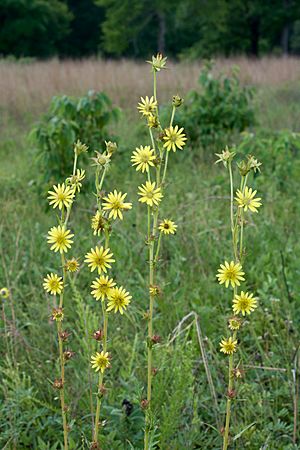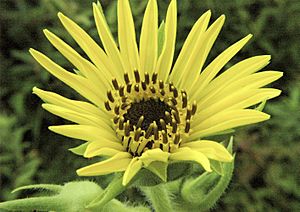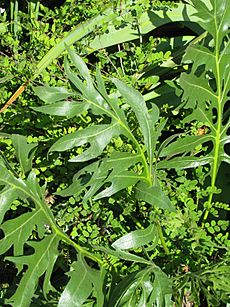Silphium laciniatum facts for kids
Quick facts for kids Silphium laciniatum |
|
|---|---|
 |
|
| Conservation status | |
| Scientific classification | |
| Genus: |
Silphium
|
| Species: |
laciniatum
|
The Silphium laciniatum is a type of flowering plant in the aster family. It is often called the compass plant because of its unique leaves. You can find it growing naturally in North America, from Ontario in Canada all the way to the eastern and central parts of the United States, even as far west as New Mexico. People also call it the prairie compass plant, pilotweed, polarplant, or turpentine plant. It belongs to a group of plants called rosinweeds, in the genus Silphium.
Contents
What Does the Compass Plant Look Like?
This plant is a taprooted perennial herb. This means it has a deep main root and lives for many years. Its rough, hairy stems usually grow quite tall, from about 1 to 3 meters (3 to 10 feet) high.
The leaves of the compass plant can be different shapes and sizes. They can be anywhere from 4 to 60 centimeters (1.5 to 24 inches) long and 1 to 30 centimeters (0.4 to 12 inches) wide. They are also hairy and can have smooth or toothed edges.
The flower head has layers of rough, sticky green parts called phyllaries on the back. Each flower head has many bright yellow petals, usually between 27 and 38 of them. It also has many small yellow disc florets in the center. After the flowers bloom, they produce a fruit called a cypsela. This fruit can be almost 2 centimeters (0.8 inches) long and has a feathery top called a pappus.
How Does the Compass Plant Point North?
The compass plant gets its name from how its large leaves are arranged. They often point north or south! The flat surfaces of the leaves usually face east or west.
When a new leaf first grows, it can point in any direction. But within two or three weeks, it slowly twists. It turns on its stem, either clockwise or counterclockwise, until it stands upright. Scientists think the sun's position in the early morning helps the leaves know which way to turn.
This special way of pointing helps the plant. When leaves face east-west and stand vertically, they get less direct sunlight during the hottest parts of the day. This helps the plant save water and stay cool.
Long ago, settlers traveling across the Great Plains used these plants to find their way. Even in the dark, they could feel the leaves to figure out which direction was north or south. One early explorer, William Clark Kennerly, wrote about naming the plant in 1843. He noticed its large, flat leaves always pointed north and south.
Who Lives on the Compass Plant?
Many different kinds of insects love to live on the compass plant. A single plant can grow up to 12 stems. Scientists have found almost 80 insects living on or inside each stem!
Most of these insects are tiny gall wasps. These wasps lay their eggs inside the plant's stem. When the eggs hatch, the plant forms a small, hidden lump called a gall around the wasp larva. The larva lives and eats inside this gall. It stays there through the winter and then comes out as an adult wasp in the spring. One stem can have over 600 of these hidden galls!
The adult female gall wasps find the right place to lay their eggs by smelling special chemicals that the plant releases. Male gall wasps also use these smells to find females. They wait near a gall for a female to come out so they can mate.
Other insects also live on the compass plant. Some are parasitoid wasps. These wasps attack the gall wasp larvae inside the galls. There are also beetles that bore into the stems. These beetles are also attacked by other parasitoid wasps.
Many birds and mammals enjoy eating the fruits of the compass plant. The eastern kingbird often sits on the tall stems. From there, it can watch for insects to catch and eat. Even Livestock like to munch on the compass plant.
Uses of the Compass Plant
Native American groups used the compass plant in many ways. The plant produces a bitter, sticky resin or sap. This sap could be chewed like chewing gum. The Pawnee made a special tea from the plant. Some groups even burned the dried root as a charm during lightning storms.
Today, people also grow the compass plant in their gardens. It is a unique and interesting plant to have!
See also
 In Spanish: Silphium laciniatum para niños
In Spanish: Silphium laciniatum para niños




